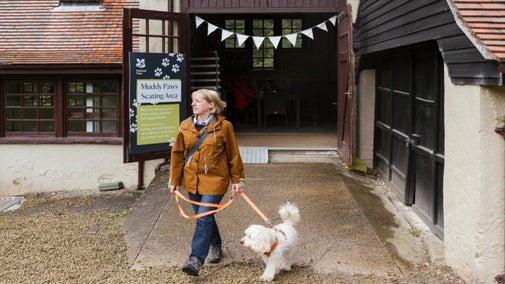
Discover more at Cape Cornwall
Find out how to get to Cape Cornwall, where to park, the things to see and do and more.

Cape Cornwall, part of the Cornish Mining World Heritage Site, is a great place to visit with your dog. You and your canine companion can explore miles of the South West Coast Path, taking in ocean views and the mining remains of an industrial past.
We’ve been working on making it easier for you to find out how dog-friendly your visit will be before you and your four-legged friend arrive. To help with this, we've created a new pawprint rating system and given all the places in our care a rating. You can find this information in the National Trust members’ handbook.
Cape Cornwall is a one pawprint rated place.
Dogs are welcome here, but facilities are limited. They’ll be able to stretch their legs in the car park and walk in the nearby open spaces, depending on the season. Read on to discover exactly where you can take your dog.
Dogs on a lead are welcome along the footpaths around Cape Cornwall. The South West Coast Path stretches for miles in both directions.
There is a seasonal dog ban on the Priests Cove beach and slipway from Easter Sunday to 30 September.
Cape Cornwall was part of a mine, because of this there are old mine shafts and adits (horizontal mine shafts) across the landscape. There are steep and unguarded drops. The terrain can be very uneven and there are some very steep routes and narrow and informal paths. Cattle or ponies graze many of our sites at different times of the year. Please don’t approach or feed livestock, keep dogs on a lead (unless cattle come close in which case you should release them) and try not to get between animals and their young.
There is a dog waste bin in the car park.
Our definition of close or effective control is:
We’ve worked with our partner Forthglade to come up with this Canine Code, which helps to make sure everyone can enjoy their day:

Find out how to get to Cape Cornwall, where to park, the things to see and do and more.

We've partnered with natural pet food maker Forthglade so that you and your dog can get even more out of the special places we care for.
From Brisons Rocks to the iconic chimney stack, coastal walks and variety of wildlife, there is lots to see and do at Cape Cornwall. See the waves of the Atlantic crash into the Tin Coast or seasonal wild flowers and meadows. Part of the Cornish Mining World Heritage Site.

If you’re bringing your dog(s) to the places we care for, you'll find information on our Canine Code and pawprint rating system, created in partnership with Forthglade, to help plan your visit.

Rest and refuel after getting out in nature with your dog. Here's a selection of the best walks with dog-friendly cafés at places we look after.

Explore the wild Tin Coast, part of the Cornish Mining World Heritage Site and see the iconic engine houses clinging to the cliff face.

Discover old mine buildings and a working steam-powered beam engine. See the wider natural landscape and wildlife that lives here.

Discover dog-friendly gardens, miles of coast paths, countryside and woodland trails on your next dog walk in Cornwall. With National Trust places in Cornwall welcoming dogs into more areas than ever before, it's a great time to stride out through the countryside and explore in the fresh air with your dog.

We've partnered with natural pet food maker Forthglade to create the Dogs Welcome project, helping you and your dog(s) get the most out of the places in our care.
